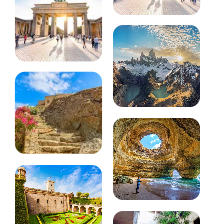Discover Lyon’s Presqu’île district
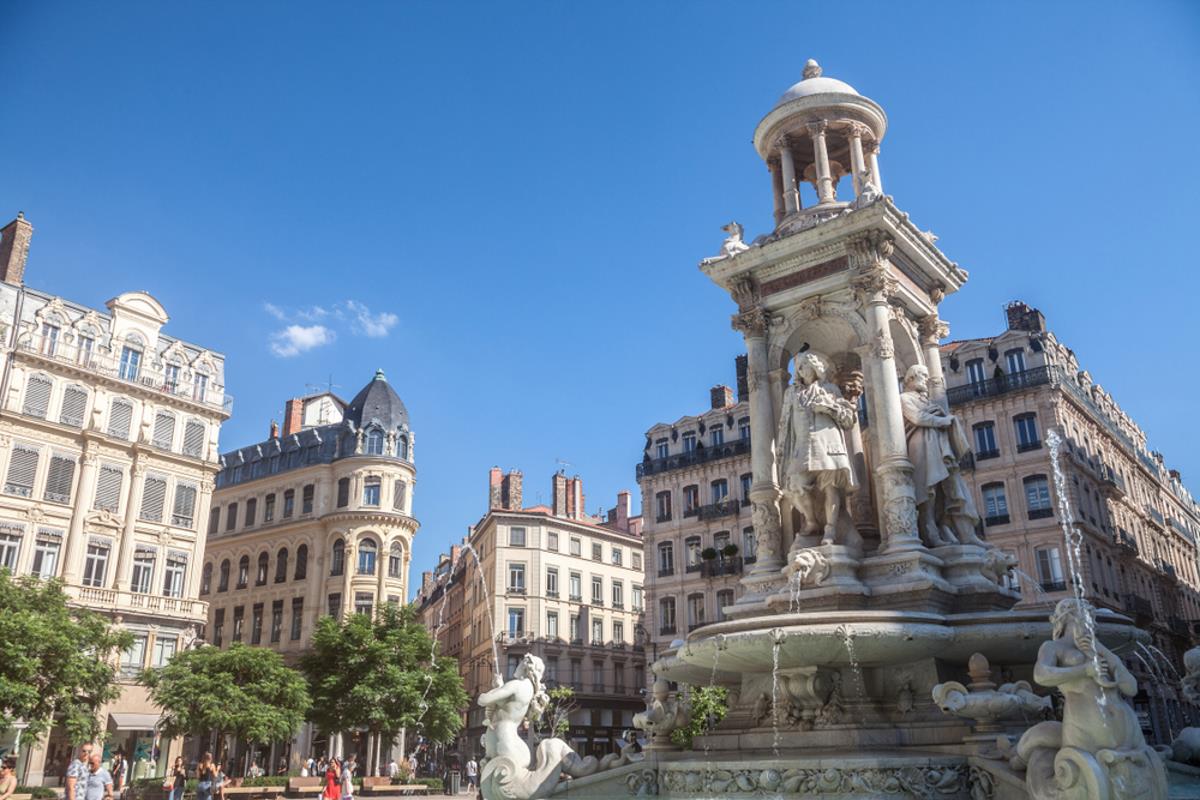
The Presqu’île is located in the heart of the city of Lyon, between the Rhône and the Saône, and is teeming with magnificent historic buildings in the Gothic, Renaissance and Haussmann styles, but locals and tourists alike also love it for its shops, its tourist attractions, its friendly terraces and its gastronomy…
Place Bellecour and Place des Terreaux are 2 of Lyon’s must-see squares. Elegant and majestic, they are both rich in history and the perfect place for window-shopping, with a choice of big names in fashion, trendy boutiques and young designers sharing the space.
There are no fewer than 3,000 shops to choose from in the Carré d’or on Lyon’s Presqu’île.
The majestic Bartholdi fountain, the Musée des Beaux-arts (Fine Arts Museum), where you can discover precious works by Picasso, Matisse, Degas and Van Gogh in a former 17th-century convent, the Musée de l’Imprimerie (Printing Museum) and the Musée des Fabrics et des Arts Décoratifs (Museum of Fabrics and Decorative Arts) are just some of the activities waiting to be discovered on the Lyon peninsula.
Introduction to Lyon’s Presqu’île district
Lyon’s Presqu’île has undergone many changes over the course of its history. Today, it includes the Terreaux, Saint-Nizier, Cordeliers, Grolée, Jacobins, Bellecour and Ainay districts, all of which are listed by UNESCO. In addition, Carnot, Perrache, Sainte-Blandine and Confluence are not listed.
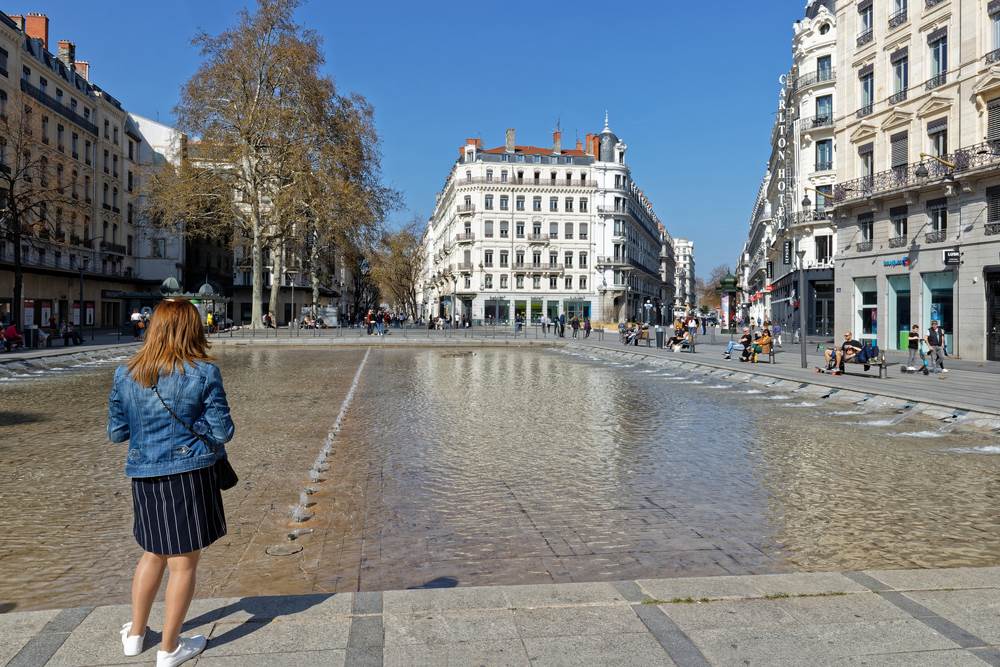
As you stroll through the streets of Lyon’s Presqu’île, you’ll find yourself surrounded by a variety of architecture from the Gallo-Roman era right up to the present day, in a maze of streets littered with emblematic sites. And while we often talk about Lugdanum, the ancient name of the city of Lyon under Roman colonisation, the history of the Presqu’île de Lyon really began with our Gaulish ancestors, the Segusiaves, who created a Celtic settlement called “Condate” below the present-day Croix-Rousse.
Condate in Celtic means confluence, a fitting name for this island located between the Rhône and Saône rivers! At the time, the inhabitants were mainly craftsmen, potters, glassmakers, bronze smiths and weavers (the future Canuts…).
After the Roman invasion, the peninsula suffered the ravages of the Huns, Saracens and floods during the Middle Ages…. It was also at this time that the island became a peninsula and that the Ainay abbey, one of the most powerful, was built. The bridge linking it to the Old Lyon district was built in the 11th century, attracting many merchants and craftsmen and increasing the number of inhabitants.
During the Renaissance, the Presqu’île made its mark on the European scene with the creation of Lyon’s fairs, which attracted both intellectuals and top-quality entrepreneurs. This period saw the beginnings of printing with the arrival of Barthélémy Buyer in 1473, and the Lyon peninsula gradually became the city’s new centre. Three decades later, the city of Lyon had no fewer than 30 printing works.
In the 19th century, Prefect Vaisse began the titanic works that were to transform the face of the Presqu’île for ever. The narrow streets were transformed into major boulevards and wide thoroughfares, and Haussmann-style buildings made their appearance.
Today, the Confluence district is proof of the revitalisation of the south of Lyon’s Presqu’île, a green urban district covering more than 41 hectares of housing, offices and leisure facilities, renovated using contemporary architecture.
What attractions are there to see on Lyon’s Presqu’île?
Lyon’s Presqu’île is not without its assets, and those who love history, heritage, architecture, window-shopping and leisure activities will all find something to suit them!
Here are a few nuggets not to be missed:
1 – Place Bellecour
This huge, central square is the largest pedestrianised square in Europe.
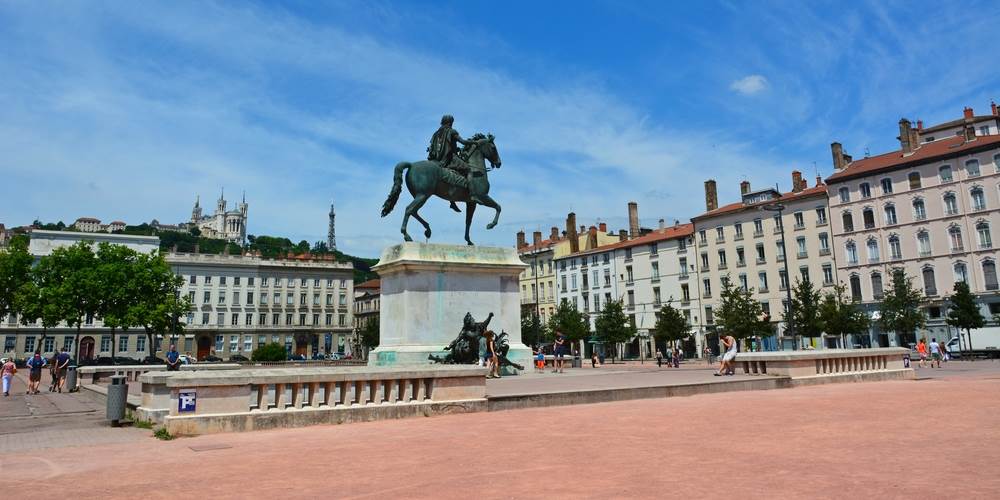
What was once a marshy area swept by floods was transformed, after its destruction during the French Revolution, into the magnificent square we know today, under the impetus of Emperor Napoleon, who took a liking to the city of Lyon. Every year, Place Bellecour plays host to numerous festive, cultural and sporting events, such as the Fête des Lumières.
- An ice rink and Ferris wheel are available in winter,
- During the Festival of Lights on 8 December, the people of Lyon place lights on their windowsills and illuminations are projected onto the façades of the city’s monuments and buildings. A fabulous sight to see at least once in your life!
- The majestic equestrian statue of Louis XIV dates from 1825, the original from 1713 having been destroyed by the revolutionaries,
- The Second World War memorial, the Pierre Vigil,
- The statue of Saint-Exupéry seated with the Little Prince was erected in tribute to this writer, aviator and reporter from Lyon,
- A park for children,
- Art galleries,
- Breweries,
- L’Huilerie Richard,
- Take a cookery course at the prestigious Institut Paul Bocuse…
2 – Place Antonin-Poncet
This square is home to the Hôtel des Postes, which was built in 1934 and in which the artist Louis Bouquet painted a 54 m long by 4 m high fresco in 1937. This fresco illustrates the influence of the city of Lyon on the world through the airwaves and transport. Also worth seeing are the bell tower of the chapel of the Hôpital de la Charité (remains of the building demolished in 1933), the pier, and the Armenian genocide memorial in the form of tall columns.
3 – The Ainay district
The Romanesque-style Basilica of Saint-Martin d’Ainay, located to the south of Lyon’s peninsula, has undergone a number of changes. Originally a Merovingian building, then a Carolingian chapel in the 10th century, it was later elevated to the rank of abbey. In 1600, King Henri IV stayed at the abbey on the occasion of his marriage to Marie de Médicis in Lyon cathedral.
But it was the Protestants who seriously damaged the building during the capture of Lyon in the 16th century. All that remained was the church of Saint-Martin, which was restored in the 19th century. Flamboyant Gothic vaulting, beautifully painted vaulted naves, medieval iconographic sculptures, references to antiquity and Romanesque features all follow one another in perfect harmony.
The Ainay district also boasts some very fine 19th-century bourgeois homes, notably on the Quai Maréchal-Joffre, as well as art galleries and antique shops.
4 – Rue Auguste Comte, Rue Victor Hugo and Rue de la Charité
The chic streets of Lyon’s peninsula.
Rue Auguste Comte is considered by some to be the most beautiful street in Lyon. The art and antique shops are legion and overflowing with precious objects: 50 antique dealers, 16 art galleries, 10 furniture and decoration shops, as well as the Maison Germain, this emblematic shop created under Louis XIV is a renowned silk shop, bookshops, a glass engraver…
Rue Victor Hugo is a well-known shopping street in Lyon, where you will find almost 40 clothing shops (Jules, Armand Thiery, D.P.A.M., Camaïeu, Pimkie, Claire’s, Brice, Jacqueline Riu, Undiz…) and around fifteen shoe shops (San Marina, Bocage…), as well as the famous Voisin cafés and chocolates, perfume and cosmetics shops…
Rue de la Charité is home to many traditional and contemporary shops, characterful bourgeois buildings and sumptuous town houses.
5 – Rue des Marronniers
Despite its name, you won’t find a single tree in this pedestrianised street, but you will find restaurants and 2 traboules, one at number 2 that takes you to Place Bellecour, and one at number 3 bis that takes you to the Théâtre des Marronniers, now a cinema.
Lyon’s little bouchons abound in the rue des Marronniers, where you can sample dishes that are emblematic of Lyon’s cuisine: tablier de sapeur, quenelles and liver cake, andouillette, tête de veau sauce gribiche… La Mère Jean, Chez Mounier, Chabert et Fils, Aux Trois Cochons, la grange des Marronniers or Chez M’man are just a few of the twenty or so little bouchons in Lyon where you can sample local specialities.
6 – Rue de la République
This main thoroughfare in Lyon’s Presqu’île is one of the city’s most beautiful streets, with sculptural facades, ornate doors and columns, beautiful wooden doors… Artists perform in this busy street, playing the violin, accordion, panpipes, guitar, biniou…
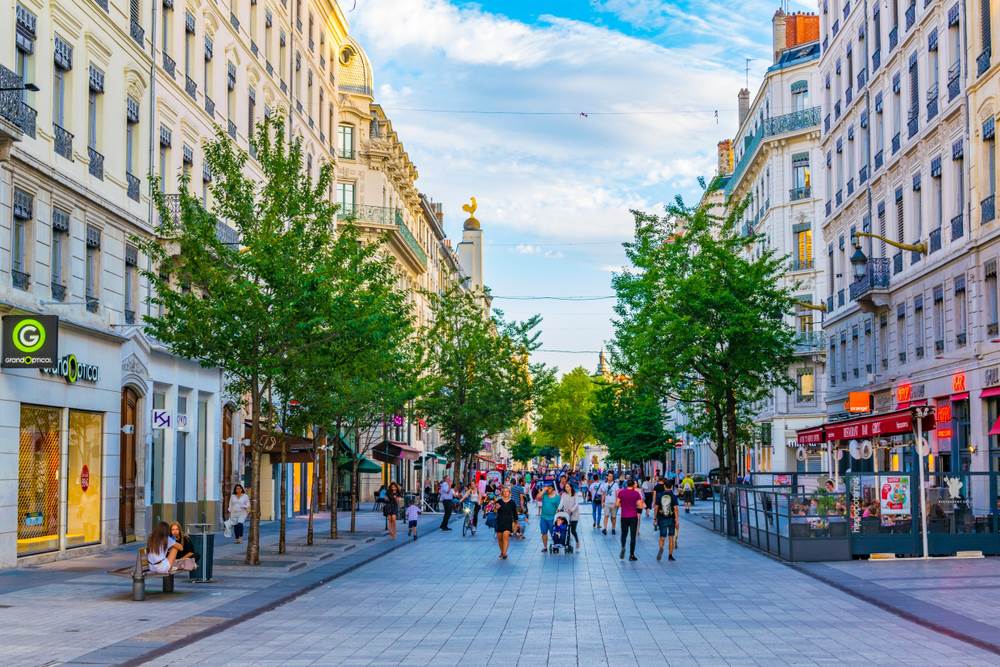
Other artists are also present: draughtsmen reproduce paintings in chalk on the cobbles, statues of men… Not forgetting the jewellers, diamond merchants and many shops that are very present in this area. Rue de la République links Place Bellecour to the Hôtel de Ville.
7 – Place de la République
Situated in the centre of the Rue de la République, it features a large fountain that is lit up by spotlights at night.
8 – Hôtel Dieu
Built in the 12th century, the building was administered by various ecclesiastical orders until it was sold to the city of Lyon in the 15th century. First a hospice, then a hospital, then a maternity hospital, it is now a 5-star hotel as well as a shopping centre dotted with trendy boutiques, offices and restaurants, where ancient and modern architecture blend together.
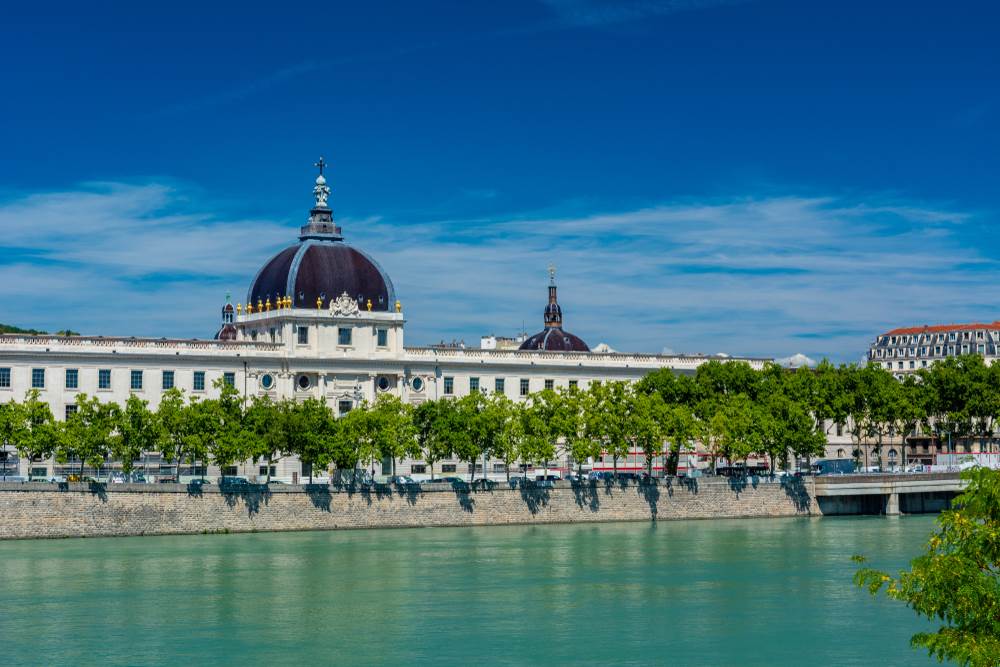
9 – Place des Jacobins
This square was once the site of a Jacobin convent that was destroyed in the 19th century. A magnificent white marble fountain stands at its centre, with statues representing Lyon artists: the architect Philibert Delorme, the sculptor Guillaume Coustou, the engraver and draughtsman Gérard Audran and the painter Hippolyte Flandrin. There is no shortage of terraces and shops near this square.
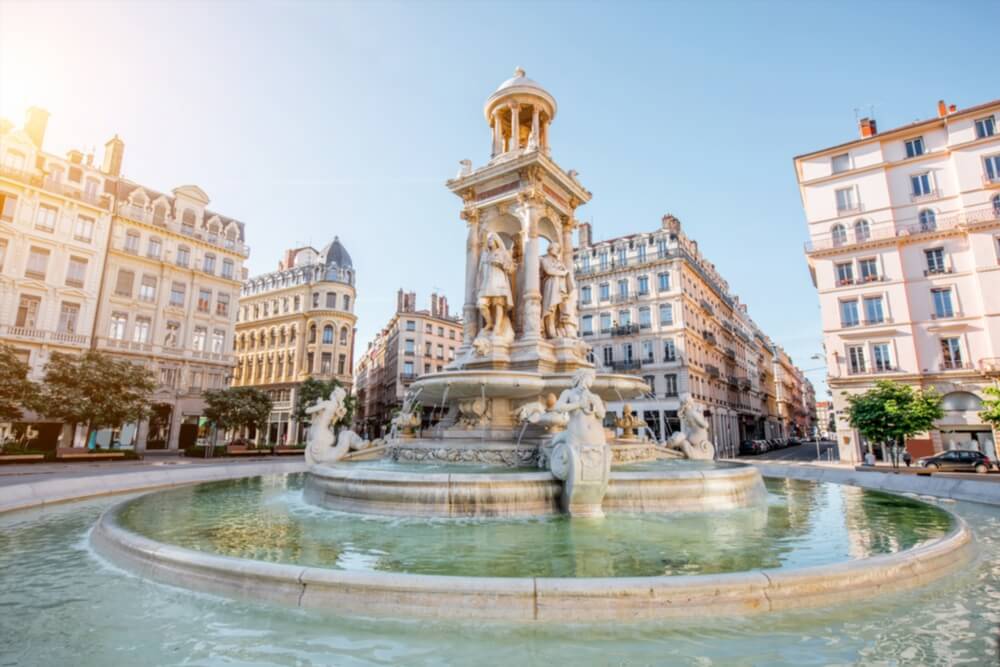
10 – The Stock Exchange Palace
The Palais de la Bourse dates back to the 19th century, and was built at the request of Lyon’s prefect Jean Marius Vaïsse. It was inaugurated by the Emperor and his wife, Empress Eugénie, in 1860. The President of the Republic, Sadi Carnot, was assassinated by an anarchist near the bourse in 1894. A red paving stone marks the scene of the crime, as does a commemorative plaque on the wall of the Palais de la Bourse.
The Salle de la Corbeille features sumptuous coats of arms on the ceiling, 24 caryatids and atlatls on the 3rd floor and a gigantic marble statue topping the clock on the first floor.
11 – Saint-Bonaventure Basilica
It is located opposite the Palais de la Bourse, built in 1327 in Gothic style, and the interior is enhanced by numerous objets d’art: statues, paintings, decorations, tapestries, stained glass windows, etc.
12 – Place de la Bourse
Facing the monumental eponymous palace, take time to admire the south-facing facade built of white and pink stone, its columns and slate roof, the sculptures and the clock at the top. The pleasant Place de la Bourse has been planted with trees and shrubs.
13 – Saint-Nizier Church
It bears the name of the bishop who was stationed in Lyon in the 6th century and who was buried at his death in what was then just a small church. Construction began in the 14th century and was completed in the 19th century. The church of Saint-Nizier is therefore one of the oldest churches in Lyon, and its two asymmetrical towers give it a unique character.
The portal is in the Renaissance style, and the exterior vault features a coffered decoration of cherubs and roses. Inside, the 1825 organ stands above the door, while the stained glass windows, bas-reliefs, marble altars and statues blend elegantly with the flamboyant Gothic style.
14 – The Lyon Opera
This classical building, inaugurated in 1756, was bought and destroyed by the city in the 19th century before being rebuilt in a neo-classical style. In 1988, the architect Jean Nouvel was chosen to renovate a poorly maintained building. The reopening in 1993 included the first opera to be performed in 1688 at the opening of the Académie royale de musique de Lyon: Phaéton by Jean-Baptiste Lully.
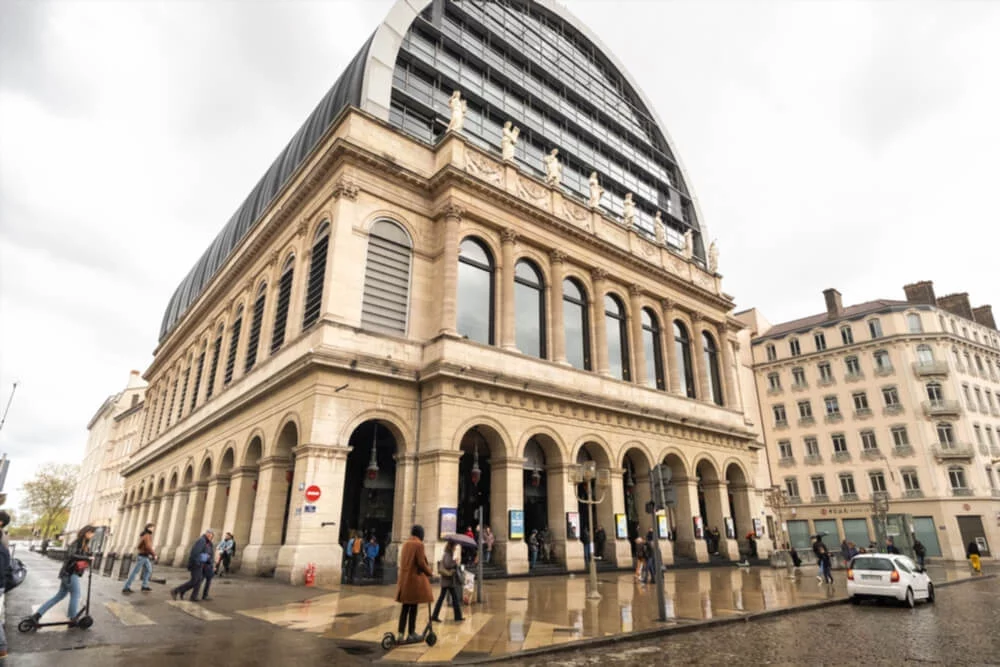
Only the walls have been preserved, including the neo-classical façade, and a contemporary glass dome now covers the building, to which a set of 8,000 red beacons has been added. The grand foyer, dating from 1831, is the only surviving room in the old theatre. Its original décor of paintings and gilding contrasts with the rest of the building. The Lyon Opera puts on shows to suit all generations and all budgets!
15 – Place des Terreaux
This perfect rectangle lies at the foot of the magnificent Croix-Rousse district, stretching from the Hôtel de Ville to the Palais Saint-Pierre. Once made up of marshy land, it was King Louis XII who pushed back the city limits of Lyon to this point in 1512. The Town Hall was built in 1672. The Place des Terreaux has always played an undeniable role in the city’s political, public and cultural life.
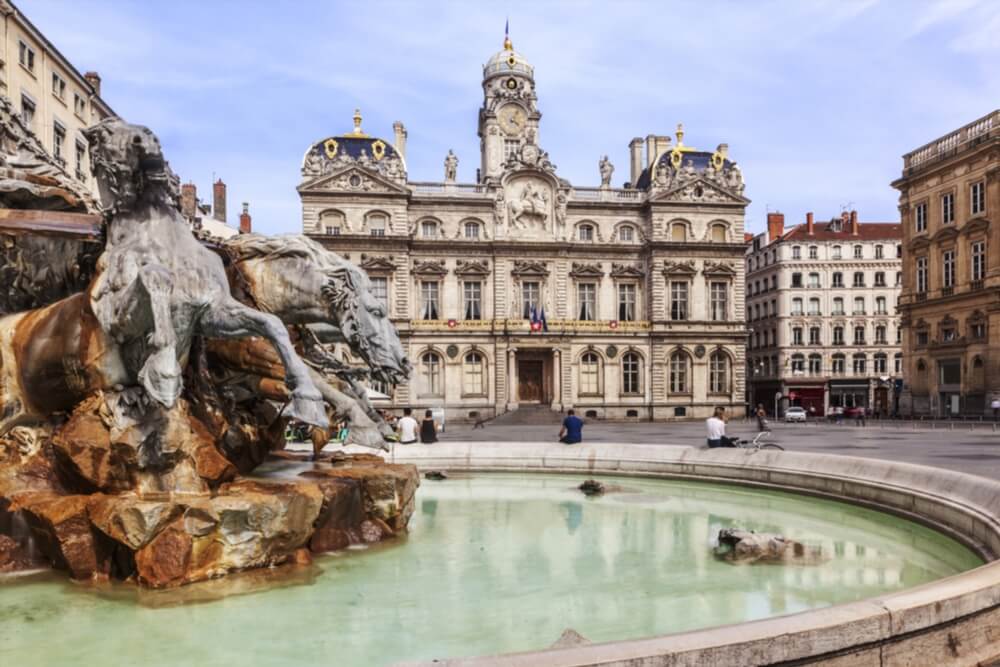
It was the site of public executions in the 17th century, and a guillotine was installed here during the Revolution. It was also the site of the “two penny riot” in 1786, followed by the Canuts uprising in 1831. Not to mention the visits of Bonaparte and General de Gaulle, who proclaimed Lyon “Capital of the Resistance” from the balcony of the Hôtel de Ville in 1944.
Sporting and cultural events, free concerts, the Festival of Lights on 8 December… The Place des Terreaux is a favourite spot for the people of Lyon.
The buildings, the café terraces, the Town Hall, the superb Bartholdi fountain with its 15 metre diameter and its 4 horses that seem to emerge from the fountain with their nostrils smoking. The Palais Saint-Pierre, now the Musée des Beaux-Arts, with its gardens, cloisters, grand staircase and seventeenth-century refectory, is just one of the wonders to be discovered on this emblematic square.
16 – The Town Hall
Despite the many fires that have ravaged the building, it remains one of the most beautiful monuments on the peninsula and in the city of Lyon. It took 26 years to complete the 4 pavilions, 2 courtyards and belfry that make up the building. The theme of the decorations in the main hall is “The Temple of Augustus”, built by the 60 Gallic nations, while that of the Great Staircase is “The Burning of Lyon under Nero”.
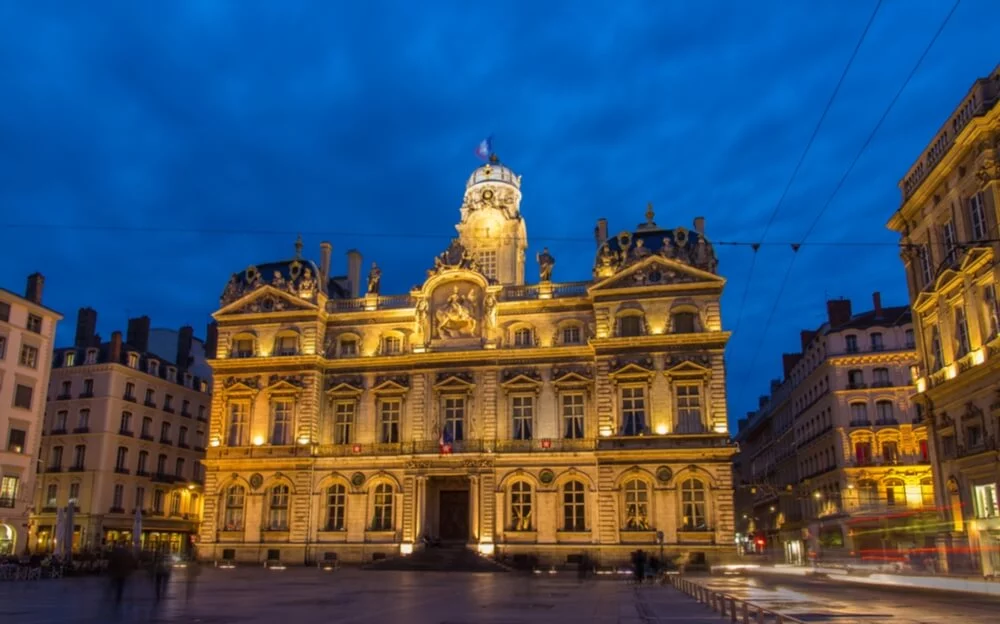
During the Revolution, the courtyard became a court of justice and executions were legion. The decorations destroyed during the Revolution were reproduced in 1853: bronze medallions, statues, silks, etc. The paintings were renovated. The town hall on Lyon’s peninsula welcomed Emperor Napoleon III and Empress Eugénie 3 times in the 19th century.
17 – Rue Mercière
This street was one of the first in Lyon’s Presqu’île district. Today it is renowned for its restaurants, but in the early days it was one of Lyon’s main thoroughfares between the various commercial bridges that fed the city. The street is also directly linked to the history of printing, dating back to the 16th century.
Thanks to its 181 printing workshops, the annual fairs ensured that works were widely distributed, making the rue Mercière the3rd largest publishing site in Europe at the time. Now a pedestrian mall, rue Mercière serves up Lyon’s gastronomic specialities to locals and tourists alike.
Le Bistrot de Lyon, considered the flagship of Lyon’s brasserie scene by Gault&Millau, is also appreciated for its authentic decor with frescoes, mirrors and gilding. Le Mercière, La Traboulerie and Les Enfants Terribles are just some of the bouchons in Lyon that will tantalise your taste buds!
18 – Place des Célestins
It takes its name from the former Célestins convent, which was built in the 16th century and also served as a patients’ dormitory, refectory, chapter house, cells and library for 400 years. Sold in 1786 by the donor to an entrepreneur, the convent was transformed into commercial buildings and a theatre. Some architectural remains from this period remain, however, including :
- The vaulted passageway topped by a 17th-century statue of the Virgin Mary at 11 place Antonin Gourju,
- The first two floors and the north and south doors of the 18th-century convent at 8 to 10 quai des Célestins,
- A Latin inscription at 2 rue Charles Dullin…
19 – Théâtre des Célestins
For over 200 years, this theatre has continued to produce dramatic works, following the example of the Comédie-Française. This Italian-style theatre, with its 2 red and gold halls, is bursting with projects and offers a high-quality programme of plays from the repertory and contemporary works. The façade features columns and an attic sculpted with garlands, lions and angels, mouldings and trompe-l’œil.
What shops are there in the area?
Lyon’s Presqu’île has something for every shopaholic, with over 3,000 boutiques. If you’re particularly keen on brands, rue Edouard Herriot is the place to go. Rue Victor Hugo and Rue de la République are among the largest pedestrian shopping areas in Europe. The Part-Dieu shopping centre is the largest in Europe. Fans of antiques will love Place Bellecour and the Auguste Comte district.
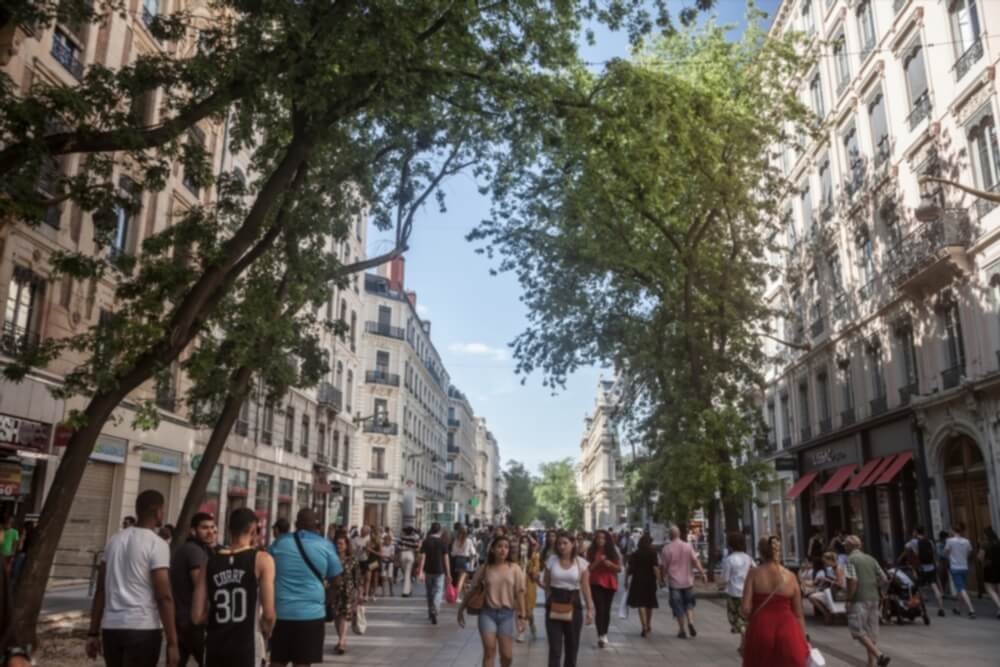
To whet your appetite, here’s a small sample of the shops on Rue de la République:
1 – Uniqlo Lyon
This Japanese brand is unique in that it controls the entire manufacturing process for its clothing lines, from design to production. Its philosophy: quality casual clothing within everyone’s reach.
Uniqlo 9 – 11 rue du Président Carnot, 69002 Lyon.
2 – Lush Lyon
A range of handmade cosmetics made from natural ingredients. From bath bombs and shower jellies to solid shampoos, Lush Lyon has products for all the family!
Lush Lyon 71 rue de la République, 69002 Lyon.
3 – Dr Martens Lyon
These shoes are instantly recognisable for their distinctive style, but they’re so comfortable and durable, they’ve become a worldwide favourite. Classic or contemporary, come and discover the whole collection!
Dr Martens 10 rue du Président Carnot, 69002 Lyon.
4 – Decathlon Lyon
The latest collections, second-hand sportswear at exceptional prices or short-term sports equipment hire, Decathlon Lyon welcomes you at 3 rue du Président Carnot, 69002 Lyon.
5 – Snowleader Lyon
This shop specialises in the sale of equipment for skiing and other mountain sports.
Snowleader Lyon: 6 rue du Président Carnot, 69002 Lyon.
6 – Horace Lyon
Quality skincare and cosmetic products for men, made in France.
Horace Lyon 49 rue de la République, 69002 Lyon.
7 – Sephora Lyon
Make-up, skincare, perfume, eyebrow bar, or a 45-minute make-up session for a new face at the top of your game, head to the world of beauty!
Séphora Lyon 53 place de la République Lyon 69002.
Which museums are worth visiting on Lyon’s Presqu’île?
1 – The Musée des Beaux-Arts, one of the largest in Europe
Located on the Place des Terreaux, this museum boasts a rich and varied collection of antiquities from the Mediterranean basin, from the Pharaohs to Ancient Rome; sculptures from the Middle Ages and the Renaissance to the 20th century; treasures of coins, medals, seals and other jewels from all periods; objets d’art from the Middle Ages to the 20th century (ivories, Limoges enamels, earthenware, etc.); paintings from the Middle Ages to modern art (Perugino, Veronese, Rubens, Fragonard, Géricault, Delacroix, Manet, etc.).), paintings from the Middle Ages to modern art (Perugino, Veronese, Rubens, Fragonard, Géricault, Delacroix, Manet…), and a graphic arts cabinet containing no fewer than 15,000 works from the 16th to the 21st century.
All this in one of the oldest monasteries in Gaul. Take time to admire the Baroque refectory and grand staircase, the 17th-century cloister and the pink marble columns in the Greek vase room, once the private oratory of the nuns’ flats.
The Musée des Beaux-Arts de Lyon is located at 20 place des Terreaux, 69001 Lyon.
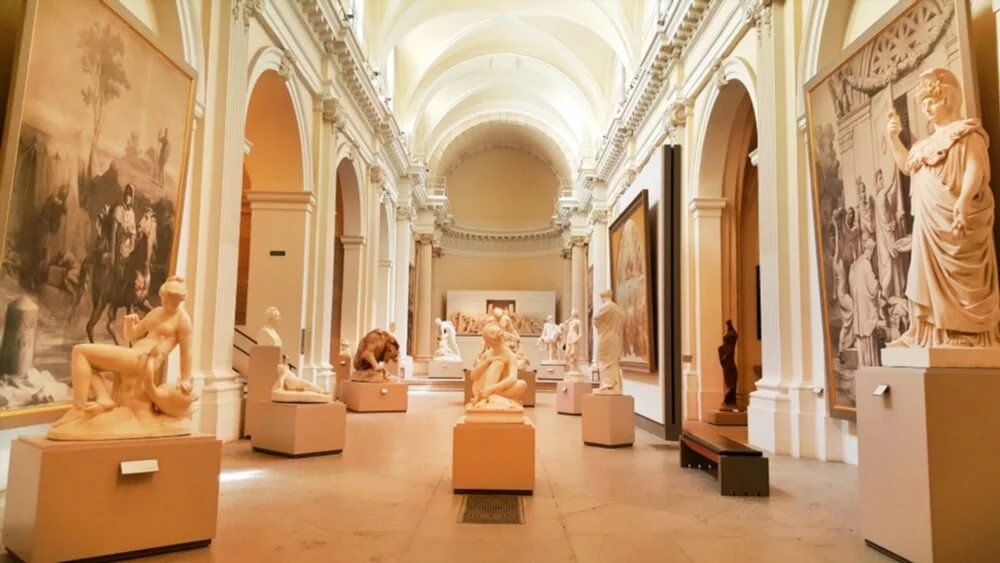
2 – The Museum of Printing and Graphic Communication
Housed in a Renaissance-style building, the museum plunges you into the history of the book and the different graphic techniques used, from its origins to photocomposition. A permanent exhibition features hundreds of books, a copy of the Claudian Tables, prints and ephemera covering a very wide period.
- Temporary exhibitions and workshops are held throughout the year. The workshops on offer include typography, engraving, illustration, calligraphy, illumination, etc.
- The oval gallery and tower are also well worth a visit.
- The Musée de l’Imprimerie et de la Communication Graphique is located at 13 rue de la Poulaillerie, 69002 Lyon.
Where to stay in Lyon’s Presqu’île?
Prestigious hotels, bed and breakfasts or more affordable hotels, you’ll find something for everyone and at every price on Lyon’s Presqu’île.
1 – Prestigious hotel on Lyon’s peninsula
Hôtel de l’Abbaye
From €160 to €300 for a double room, very comfortable, pleasant surroundings and tastefully decorated, 700 metres from Place Bellecour, 800 metres from the Célestins theatre and 1.6 km from the Musée des Beaux-arts. 20 rue de l’Abbaye d’Ainay, 69002 Lyon
Intercontinental Hotel on the Lyon peninsula
Nestled in the heart of a listed building, the Hôtel-Dieu, a 12th-century monument. This luxury hotel offers a service worthy of its 5 stars from €300 per night for a double room. 20 quai Jules Courmont, 69002 Lyon.
2 – Presqu’île de Lyon bed and breakfast
A night in the second
Located in a 19th century building, the 30 m2 room, with private bathroom and lounge area, offers all the charm of old flats with high ceilings and period mouldings. A subtle blend of classic and contemporary, from €130 per night for a double room, 600 m from Place Bellecour and 200 m from the Ampère metro station. 11 rue Jarente, 69002 Lyon.
3 – More affordable hotels
Hotel Vaubecour
From €55 a night, this charming hotel in the heart of Lyon’s peninsula has retained an authentic feel with its mouldings, high ceilings and period fireplaces. This 2-star hotel is located 100 metres from the banks of the Saône and Ainay Abbey. 28 rue Vaubecour, 69002, Lyon.
The ibis budget Lyon Confluence
Soundproofed room with private bathroom from €54 per night, 700 metres from Lyon-Perrache station and 1 km from Lyon’s old town. 24, quai Perrache, 69002 Lyon.
In conclusion
The Lyon peninsula has no shortage of charm, historical, architectural, gastronomic and artistic assets. A place that can appeal to all kinds of holidaymakers: solo, with family or friends, whether for a weekend or longer. Come and discover all the secrets of Lyon’s peninsula, from antiquity to the present day, and leave with plenty of memories of the capital of the Gauls!
Did you know?
“C’est l’hôpital qui se moque de la charité” is a well-known expression in France, but do you know exactly where it comes from? Lyon, of course! And more precisely, from the Lyon peninsula, where the Hôtel-Dieu and the Charité (of which all that remains is the bell tower on Place Antonin Poncet) were rival hospices, and denigrated the services provided by one or the other, even though they were doing exactly the same thing: welcoming the sick to the hospice, helping the poor… It implies that these 2 rivals ultimately had the same faults, which is where this famous expression originated.
200 audioguided tours for cities all around the world
Download